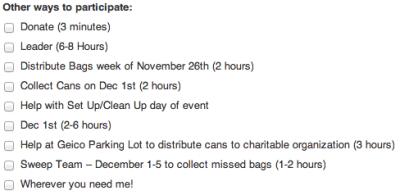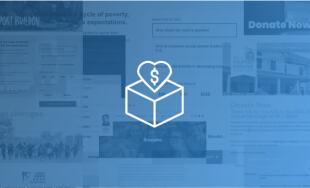Time and resources are often limited for nonprofits and an organization's website is a cost-effective way to get information to people who are interested in contributing to its mission.
We have built dozens of websites for nonprofits across the world, and while a beautiful web design helps complimenting the organization's objectives and gives visitors a visual of the organization's impact, the content on a website often doesn't adequately convey the organization's influence on its community.
Before diving into the specific ways in which your nonprofit can quickly and effectively improve its website content, it's important to take a second and determine the concrete goal(s) of your nonprofit's website. All of the content on your site should keep those end-goals in mind. Below are some possible goals that you may have for your organization's website:
- Increase donations (monetary or a specific items like clothes, canned goods, etc.)
- Increase volunteers
- Spread information or awareness
- Collect petition signatures
- Promote an upcoming campaign
Once you have established a few concrete goals for your website, here are some questions you should be asking in order to improve your website and better accomplish those goals.
Nonprofit Checklist:
- When is the last time you rewrote or updated your 'about' page?
- Can site visitors easily learn about real-life examples of your organization's impact?
- How many pages on your site have more than three paragraphs of content and zero pictures or videos?
- When someone is on your donate page, do they know the specific impact their donation will have?
- Do potential volunteers know how much time they can expect to give and how that time will specifically help?
- Can visitors connect with your organization on any page of the site?
- Are more than half of your social media updates promotional?
- Have you written anything new on your site in the last week?
When is the last time you rewrote or updated your 'about' page?

The beautiful thing about nonprofits is that they all tell a story. That story should be told with an emphasis on emotion. The story could be why the organization was started, how the organization impacted the life of someone or a group of people, or what a future change will do for community members. It's extremely important that a nonprofit's story is clearly and prominently displayed on the organization's website. More importantly, the story needs to be impactful, convincing and connect with the reader on an emotional level.
Does your about page succinctly tell what the organization does and why it matters? The about page is likely one of the most visited pages on a website and is often the first place an organization has the chance to convey its importance to visitors who want to learn more about the nonprofit.
Can site visitors easily learn about real-life examples of your organization's impact?
Your nonprofit should have an area of the site where you tell specific examples of how your organization influenced an individual or a community in a positive way. Ideally the examples will be directly from the people whose lives were improved in some way by your organization. If you have to write the stories yourself, however, that's okay too. A nonprofit's 'case studies' are often more effective because the result is a feel-good message to your audience. A few real-life examples are:
- A testimonial from someone whose life was improved by your organization's endeavors
- A volunteer spotlight to highlight the impact of one volunteer's efforts
- A gallery of before and after pictures of a community that was helped by your work
How many pages on your site have more than three paragraphs of content and zero pictures or videos?
Pictures and video not only make webpages easier to read, they also improve the average time a visitor spends on that page. Pictures and videos are also a fantastic way to visually produce an emotional reaction from your website visitors. In today's world, most people have a camera on their phone that can produce high-resolution images and video that are perfectly suitable for your website. Here are some ways you can collect multimedia for your organization's website and other marketing materials:
- Encourage volunteers and staff to take pictures when they're working
- Ask for images and video through social media
- Post a link on your website that says something like, "Did you help contribute to our mission? Send your pictures or videos to info@nonprofitorganization.org and we'll share them on our site!"
When someone is on your donate page? Do they know the specific impact their donation will have?
 Your donation page should tell the potential donor how their donation will impact the world. It's probably common sense that a bigger donation will have a bigger impact. If you can succinctly show that principle, however, you will be more likely to get larger donations more frequently. Here are two examples of donation pages:
Your donation page should tell the potential donor how their donation will impact the world. It's probably common sense that a bigger donation will have a bigger impact. If you can succinctly show that principle, however, you will be more likely to get larger donations more frequently. Here are two examples of donation pages:
General Donation Request:
Donate now for a brighter future for children across the world. Your donation is greatly appreciated!
- $25
- $50
- $100
- $250
- Other
Specific Donation Request:
We raise more than 93% of our annual funding through the generous support of individuals and businesses like you. Please give generously! We appreciate your kindness!
- $76 – Covers the cost of lodging and support services for a family for one night
- $100 – Provides milk, juice, and eggs for families for one week
- $532 – Shelters a family in need for one one week
- $1,000 – Keeps the lights on at the House for two weeks
- Other – Even just $10 provides a meal for one of our families
By giving the specific ways that a visitor's donation will make an impact, potential donors can connect an abstract amount with a concrete result.
Do potential volunteers know how much time they can expect to give and how that time will specifically help?
 Similar to donations, you should explain clearly how your volunteers will help the community by giving their time. Not only does this set realistic expectations for volunteers, but it gives them an idea of the real-world impact they can make with their time. Instead of simply asking for a volunteer's name, email address and phone number, break down the different ways that they can help out.
Similar to donations, you should explain clearly how your volunteers will help the community by giving their time. Not only does this set realistic expectations for volunteers, but it gives them an idea of the real-world impact they can make with their time. Instead of simply asking for a volunteer's name, email address and phone number, break down the different ways that they can help out.
Can visitors connect with your organization on any page of the site?
 You can't be sure which page of your site is going to convince a visitor to get involved with your organization. Accordingly, visitors need to be able to quickly form a longer-term relationship with your organization on any page of the site. There are many ways to connect with visitors and one, if not several of these actions should be readily available on any page of the site:
You can't be sure which page of your site is going to convince a visitor to get involved with your organization. Accordingly, visitors need to be able to quickly form a longer-term relationship with your organization on any page of the site. There are many ways to connect with visitors and one, if not several of these actions should be readily available on any page of the site:
- Like your organization on Facebook
- Follow your organization on Twitter
- Subscribe to your organization's email updates
- Sign up to volunteer
- Subscribe to your blog
- Contact your organization
- Attend an upcoming event
- Apply for a grant
Don't forget to make it easy for a visitor to share what they're doing on social media when they get involved with your organization.
Are more than half your social media updates promotional?
The best real-life conversations happen when all parties contribute to the dialogue. The same is true online and when your social media posts are all one-way notices, the 'social' aspect is suppressed. Make it a goal for no more than half of your social media updates to be promotional. Instead of reposting your latest newsletter, blog post or donation campaign, try some of the following approaches:
- Ask a question and respond to the answers
- Comment on a conversation that's already going on related to your nonprofit's industry
- Reply to a recent news story related to an issue that matters to your organization
- Repost a feel-good story that someone else wrote
Have you written anything new on your site in the last week?
If someone is on your website, they want to know about what your organization is doing. Creating new content is not only great for SEO, it's also the best way to keep your website fresh and evolving. You should make it a goal to write new content on a regular basis. It may be too difficult to put the content creation responsibility all on one person. Instead, set up a content schedule and have each of your staff-members write a new post once a month. Your nonprofit is doing great things for the world. Write about it and make it easy for people to share!
Here are some questions to help you brainstorm topics:
- What have you done recently?
- What is your next initiative? What are your goals? What can people do to help you reach that goal?
- Was there a story in the news that impacted your organization or the people you affect?
- Did one of your volunteers or staff-members do something noteworthy?
- Did someone you helped go on to do something great?
Your website content greatly affects how well your website is able to accomplish the concrete goals that you've established for your online presence. Keeping those goals in mind is a must when you write and update your website's content. By asking yourself the questions outlined in this post, hopefully you learned a few specific ways that you can improve the content on your organization's website.
If you have any other suggestions for ways that nonprofits can improve the content on their site, definitely let us know in the comments. And of course, reach out if you're interested in learning more about how we can help improve your nonprofit's web presence!




Comments
Calvin Austin
i just started an NGO page on facebook. i will like to know how to promote and get people involved to participate in my NGO. do u have any suggestions?Leave a comment